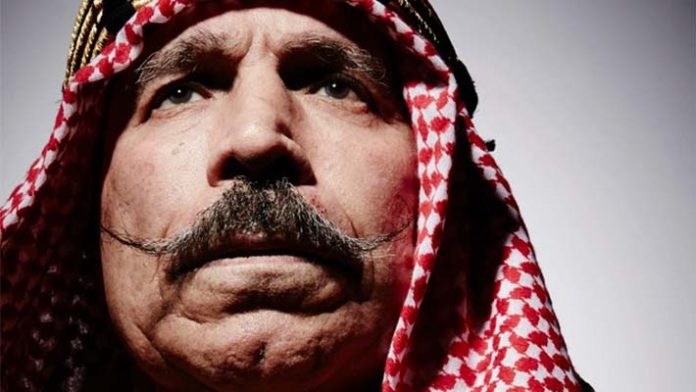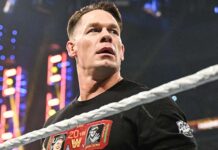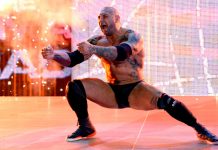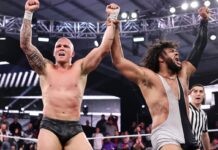
It was with incredible sadness that I read the news on social media yesterday that the legendary Iron Sheik passed away at the age of 81. Reaching his peak in main stream popularity in the mid-80s during the WWF’s national expansion, the over-the-top Iranian, complete with the flag of his native country and his signature pointed-toe boots, along with his trademark mustache, the villainous grappler riled up the audience, as the foreign menace with anti-American mic work in his distinct accent. Despite the jeers he generated from the fans, The Iron Sheik was pure entertainment.
Ironically, the real-life Khosrow Vaziri was a prime example of the American dream, a stark contrast to his on-screen persona.
Vaziri made a name for himself in his early years in his home country as a stellar amateur wrestler, competing in the 1968 Olympics as a members of the Greco-Roman team. He was so well-regarded for his legitimate wrestling skills that he even worked as a body guard for the Shaun of Iran. Political tension was ripe toward violence with protests against the oppressive government regime. Gholamreza Takhti,who the young Vaziri considered an inspiration, was viewed as a national hero for his own accomplishments in amateur grappling, winning Olmpic gold for Iran years earlier before he retired from competition. Takhti used his status as a legendary sports figure in the country to assist many charities and was an advocate for improvements for the citizens of the region. With his immense popularity, many assumed that Takhti could’ve pursued political status in Iran, but he mysteriously died in 1968. The public assumed that the reports of suicide were a cover up for a government assassination to avoid political opposition. In a 2014 documentary about his life, Vaziri explained that the death of the Olympic champion is why he fled Iran because he didn’t want to eventually become a target of the Shaun if his own amateur accomplishments were seen as a threat to the regime’s power.
The Iron Sheik eventually battled against the all-American Hulk Hogan character, but when Khosrow Vaziri landed in the United States in 1970, he was a confidant to America.
Khosrow’s reputation as a top-notch athlete was well-known, and he worked as a coach for the USA amateur wrestling team during the early-70s, including as an assistant coach for the 1972 Olympics. With his extensive experience and coaching in the amateur game, it actually wasn’t too surprising that he made the transition to the pro ranks under the guidance of the legendary promoter of the AWA, Verne Gagne, who had his owner experience on the amateur mats. Verne was also involved with Team USA when he sponsored Ken Patera during his tenure in the Olympics. Khosrow was a part of Gagne’s famous 1972 training group that included many that went on to make a major name for themselves in sports entertainment, such as Ric Flair, who was originally a Minnesota native.
After he started in the AWA, a group that was based in Minneapolis, in 1973, the man that would become The Iron Sheik worked under various names in various promotions over the next decade, including Jim Crockett Promotions, the Mid-South territory, and many other organizations.
As we know, The Iron Sheik received his greatest exposure and was launched to fame when he arrived in the WWF in the early-80s ahead of Vince McMahon’s national expansion. The boot camp match against Sgt. Slaughter in 1980 was one of the most famous bouts in Madison Square Garden history so the north east audience was familiar with him when returned to the area in 1983. In the latter stages of that year, as Vince McMahon was poised to associate his wrestling league with the newly-launched MTV channel on the emerging cable systems, The Iron Sheik was an extremely colorful character that was showcased to a mainstream audience throughout the Rock N’ Wrestling era.
The Iranian villain generated a tremendous amount of heat from the audience and played a key role in the launch of Hulkamania that fueled much of the surge in popularity throughout the 80s.
The Iron Sheik was chosen for this pivotal role because of the amount of heat and legitimacy that he brought to the table. Bob Backlund reigned as the champion for six years prior to the national expansion, but McMahon knew that a new era required a new champion, and the way to propel his next All-American star was a key piece of the puzzle. Sheik beat Backlund for the WWF title to transition the belt to Hulk Hogan, who pinned the Sheik in January of 1984 to claim the championship for America. That victory is what solidified Hogan as the top star, and the argument could be made that if Hulk didn’t have a strong heel to defeat then his major successful wouldn’t have been launched as well as it was because he had credibility with a win against The Iron Sheik.
After dropping the WWF title, Vaziri worked the mid-card of the organization, but always remained an entertaining persona with his wild promos and over-the-top mannerisms in the ring. In a business comprised of memorable characters, in an era with some of the most well-known competitors in the history of the industry, The Iron Sheik stood out as prehaps the most colorful of them.
Unfortunately, some fans might not realize that at his peak of exposure, The Sheik was already in his early-40s and was past his physical prime of a decade earlier. In May of 1987, Vaziri was arrested for drug possession during the infamous Jim Duggan incident when the two grapplers that were feuding on-screen were caught with drugs after they were pulled over by police on the highway. The incident garnered media attention and the two were fired at the time. Sadly, the exposure to the pitfalls of the 80s, particularly for those in the wrestling business had affected the former WWF champion. While he made various comebacks over the years, including brief stints as a wrestler in 1988 and 1991 for the WWF, drug use had clearly taken a toll on him. His two-year tenure in WCW between WWF returns, was almost embarrassing as weight gain and injuries drastically affected his mobility in the squared circle. In 1996, he was brought back to the WWF yet again for a manager role, but left the organization the following year.
Sheik still worked the independent circuit throughout the late-90s, but drug use made the legendary grappler a shell of himself.
In the mid-2000s, The Sheik garnered notoriety for his profanity-laced shoot interviews, where he wildly went on extended rants in broken English about a supposed grudge against Brain Blair, and the threat to make all of his foes humble with the camel clutch. The interviews were so outrageous that a new generation discovered the Iranian star on Youtube. In reality, the aging legend was using the gimmick of his outlandish outburst to rejuvenate his career in his later years. With the help of Page Magen and Jian Magen, a Twitter account was launched that was supposedly written by the grappler. The Magen brothers actually ran the account, but it became a favorite on the social media platform. The Sheik’s renewed popularity made him a social media celebrity, which garnered him appearances on The Howard Stern show and other media outlets. The previously mentioned 2014 documentary told the real-life story of Khosrow Vaziri, revealing that while the outrageous character was a work, the real guy underneath the persona was an endearing man that appreciated the opportunities that America brought him.
Finally clean from substances, The Iron Sheik seemed that he found a place of peace in his life in more recent years and enjoyed his status as a beloved legend of the industry. If I had to guess what made Vaziri so endearing is that when he was inducted into the WWE Hall of Fame, he expressed his appreciation for his peers and fans, and even through the thick accent, you could tell that he was genuine. In regular interviews when he wasn’t trying to work the outrageous gimmick, you could see the authenticity when he expressed gratitude for America and the respect he had for his peers in the sport.
It’s ironic that the role of villainous Iron Sheik was actually an example of the American dream for Khosrow Vaziri when he came to the United States in search of a better life and eventually became one of the most memorable characters in the history of the professional wrestling industry.
My sincere condolences to Khosrow Vaziri’s friends and family at this difficult time.
What do you think? Share your thoughts, opinions, feedback, and anything else that was raised on Twitter @PWMania and Facebook.com/PWMania.
Until next week
-Jim LaMotta
E mail [email protected] | You can follow me on Instagram & Facebook @jimlamotta89







